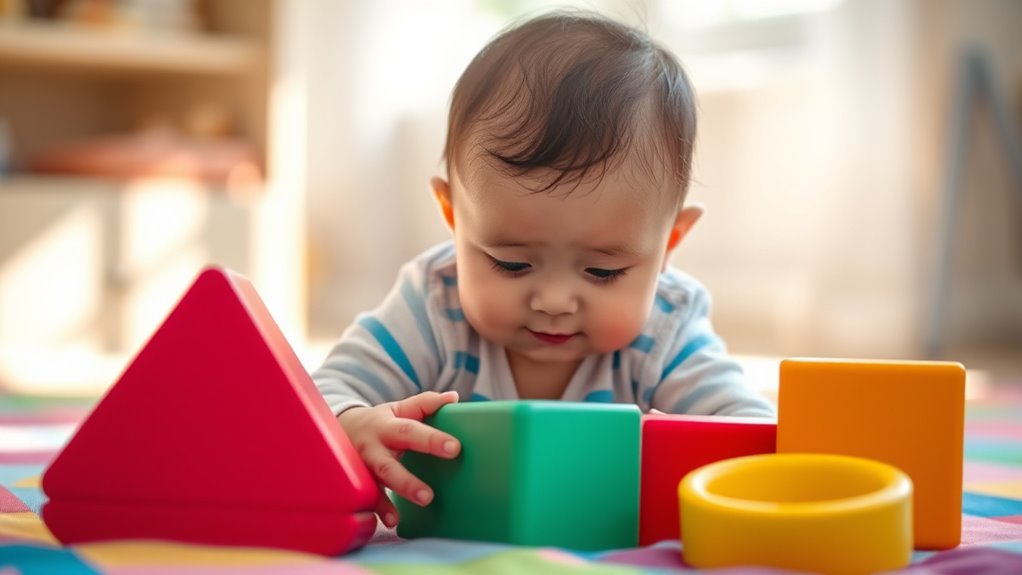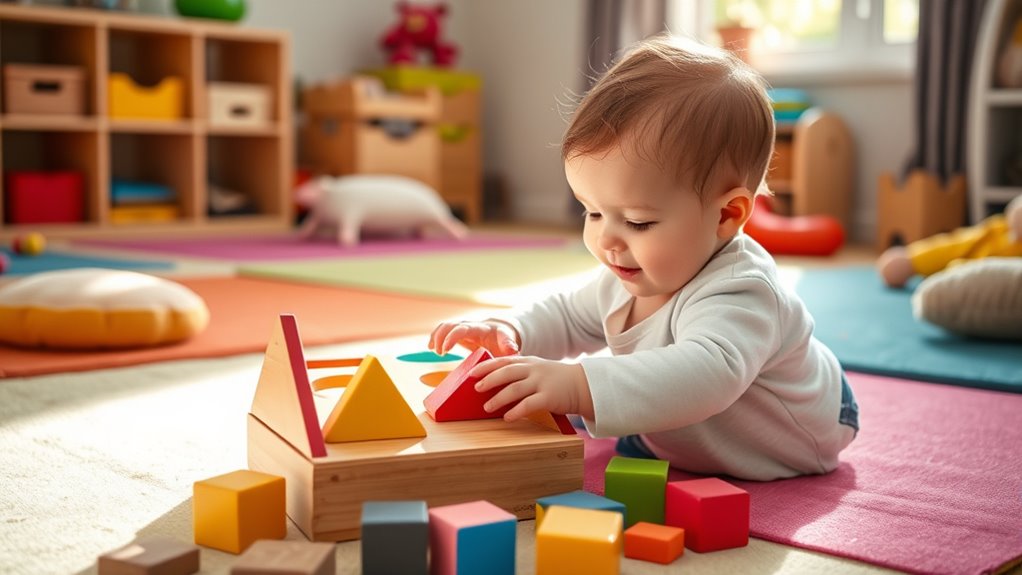Baby’s shape sorting activities are fantastic for enhancing your baby’s early learning. These activities boost cognitive skills and fine motor development while introducing basic math concepts like counting and sorting. As your little one explores different shapes, they’ll improve their problem-solving abilities and spatial awareness. Playing together also fosters bonding and enriches vocabulary. If you’re curious about all the benefits shape sorting can offer, there’s much more to discover!
Key Takeaways
- Shape sorting toys enhance cognitive growth and fine motor skills through problem-solving and spatial awareness development.
- Engaging in shape sorting introduces basic mathematical concepts like counting, sorting, and recognizing patterns.
- Parent-child interaction during shape sorting fosters bonding and enriches vocabulary through the use of spatial language.
- Non-electronic shape sorting toys encourage more interactive learning experiences compared to electronic alternatives.
- Repeated practice with shape sorting builds hand-eye coordination and confidence in object manipulation.

As your baby engages in shape sorting, they’re not just playing—they’re building essential cognitive and motor skills. This simple activity enhances problem-solving abilities and boosts spatial awareness, laying the groundwork for future learning. By figuring out how to match the shapes with the corresponding holes, your little one practices critical thinking and reasoning skills. It’s fascinating to see them explore and discover how different shapes fit together, which not only promotes cognitive growth but also sparks curiosity.
Shape sorting toys are perfect for developing fine motor skills and hand-eye coordination. Your baby will need to grasp and manipulate each shape, honing their dexterity as they learn to control their movements. These toys require precise actions, which translates into greater confidence when handling everyday objects as they grow. The more they practice, the more adept they become at using their hands.
Shape sorting toys enhance fine motor skills and hand-eye coordination, empowering your baby to confidently navigate the world around them.
Moreover, engaging in shape sorting introduces your child to basic mathematical concepts like counting and sorting. As they categorize shapes by color and size, they’re unknowingly laying the foundation for future math skills. This early exposure to numbers and classification helps them recognize patterns, which is vital for future academic success. You’ll notice that as they sort shapes, they start to develop an understanding of how things relate to one another in space.
When you join in on the fun, your involvement can significantly enhance their learning experience. Interacting during shape sorting not only fosters a bond between you and your child but also enriches their vocabulary. Using spatial language—like “above,” “below,” or “next to”—while playing can greatly improve their communication skills. Your encouragement and dialogue will engage them further, making the learning process even more enjoyable.
Traditional shape sorting toys often promote more interactive learning than electronic ones. While electronic toys can be entertaining, they might limit parent-child interactions and the use of spatial language. By opting for non-electronic options, you can create a more enriching environment that encourages conversation and learning. Additionally, incorporating STEM toys can further enhance your child’s problem-solving and critical thinking abilities as they grow.
Frequently Asked Questions
What Age Is Best to Introduce Shape Sorting Toys?
You can introduce shape sorting toys as early as 6 months. At this age, focus on larger, safer shapes that promote sensory exploration.
As your child grows into toddlerhood, around 1 to 3 years, you can introduce more complex shapes to challenge their fine motor skills.
By preschool age, they’ll refine their shape recognition and sorting abilities, enhancing their cognitive development.
Choosing age-appropriate toys ensures they’re engaged and learning effectively.
Are There Specific Shapes That Are Easier for Babies to Sort?
When considering the delightful journey of shape sorting, you’ll find that certain shapes naturally lend themselves to easier classification for little ones.
Typically, circles, squares, and triangles are the more approachable shapes for babies, allowing them to grasp sorting concepts with relative ease.
These basic forms provide a solid foundation for their budding cognitive skills, making the experience both enjoyable and enriching as they explore the world around them.
How Can I Make Shape Sorting More Challenging for My Baby?
To make shape sorting more challenging for your baby, introduce multiple shapes at once and gradually add complex shapes like hexagons.
You can create combinations that require sorting by different attributes, or even blindfold your baby to enhance tactile recognition.
Setting time limits can also encourage quicker sorting.
Incorporate sensory experiences with textured shapes and interactive containers to keep it engaging while developing their cognitive and fine motor skills further.
What Materials Are Safest for Baby Shape Sorting Toys?
When selecting shape sorting toys for your baby, prioritize materials like natural wood and recycled plastics.
These options are non-toxic and eco-friendly. Ensure any paints used are water-based to avoid harmful chemicals.
Look for toys made from bioplastics or organic fabrics for added safety. Always check for Greenguard certification to guarantee low chemical exposure.
Can Shape Sorting Toys Help With Language Development?
Yes, shape sorting toys can definitely help with language development.
When you play with your child using these toys, you introduce them to new words related to shapes and colors. By describing what you’re doing, you encourage your child to use spatial language, enhancing their communication skills.
Plus, sorting shapes helps them grasp concepts like “in” and “out,” which are essential for their overall language growth. Your engagement makes a big difference!
Conclusion
In the grand adventure of early learning, shape sorting is a treasure trove of discovery for your baby. As they fit each shape into its rightful place, they’re not just playing; they’re building vital skills that lay the foundation for future learning. Embrace these moments, because every little triumph, like fitting a square into a square, is a step towards a world of understanding. So, let the joy of learning shape their journey!









